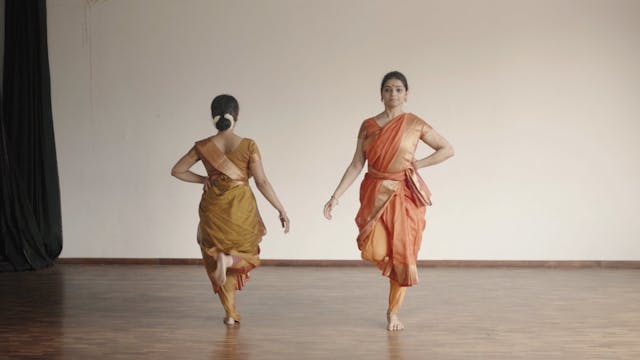Devata Hasta
The hand gestures that depict the various gods and goddesses according to the Abhinaya Darpana
अथात्र ब्रह्मरुद्रादिदेवताभिनयक्रमात्
मूर्तिभेदेन ये हस्तस्तेषां लक्षणमुच्यते
Athātra brahmarudradidevatabhinayakramāt
Mūrtibhedena yé hastasteśām lakśanmūćyaté
Deity Right Hand Left Hand
1. Brahma Hamsa Chatura
2. Shiva Tripataka Mrugashirsha
3. Vishnu Tripataka Tripataka
4. Sarasvati Soochi Kapitta
5. Parvati Ardhachandra Ardhachandra (tilted down)
6. Lakshmi Kapitta (shoulder level) Kapitta (shoulder level)
7. Ganesha Kapitta (waist level) Kapitta (tilted down at waist level)
8. Kartikeya Shikhara Trishula
9. Manmatha Katakamukha Shikhara
10. Indra Tripataka Tripataka
11. Agni Tripataka Kaangula
12. Yama Soochi Tamrachuda
13. Nairutti Shakata Katva
14. Varuna Shikhara Pataka
15. Vaayu Arala Ardhapataka
16. Kubera Mushti Alapadma
Up Next in Abhinaya Darpana
-
Ćaris (Abhinaya Darpana)
A Ćari is a type of gait or manner in which the body can move. Taken from the root word 'ćar' to move in sanskrit, it represents a movement through space. The ćaris of the Abhinaya Darpana are very different from the ćaris of the Nātyaśaśtra
These types of gaits are used primarily to communicate...
-
Mandala Bheda
The leg positions according to the Abhinaya Darpana are very different from the Natyaśaśtra. Mandala, itself has a different meaning in both the texts. Please remember to note that this śloka is specifically from the Abhinaya Darpana.
स्थानकं चायतालीढम् प्रेण्खणप्रेरितानि च
प्रत्यालीढम् स्वस्... -
Sthānaka Bheda
Th Sthanaka Bheda in the Abhinaya Darpana are quite varied from those that we call Sthanakas in the Natyaśaśtra. Be sure not to be confused with one another.
samapaadanća eka paadam naagabandhasthatha param
aindreća garudasćaiva brahmastanamithi kramam1. Samapāda – standing with both feet ali...


